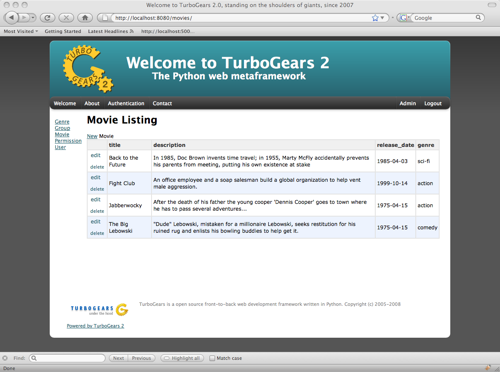tgext.crud.controller¶
Overview¶
This is a simple extension that provides a basic controller class that can be extended to meet the needs of the developer. The intention is to provide a fast path to data management by allowing the user to define forms and override the data interaction with custom manipulations once the view logic is in place. The name of this extensible class is CrudRestController.
What is CRUD?¶
CRUD is a set of functions to manipulate the data in a database: create, read, update, delete.
Um, REST?¶
REST is a methodology for mapping resource manipulation to meaningful URL. For instance if we wanted to edit a user with the ID 3, the URL might look like: /users/3/edit. For a brief discussion on REST, take a look at the microformats entry.
Before We Get Started¶
Here is the model definition we will be using for this tutorial:
from sqlalchemy import Column, Integer, String, Date, Text, ForeignKey
from sqlalchemy.orm import relation
from moviedemo.model import DeclarativeBase
class Genre(DeclarativeBase):
__tablename__ = "genres"
genre_id = Column(Integer, primary_key=True)
name = Column(String(100))
class Movie(DeclarativeBase):
__tablename__ = "movies"
movie_id = Column(Integer, primary_key=True)
title = Column(String(100), nullable=False)
description = Column(Text, nullable=True)
genre_id = Column(Integer, ForeignKey('genres.genre_id'))
genre = relation('Genre', backref='movies')
release_date = Column(Date, nullable=True)
Putting The CRUD Into REST¶
EasyCrudRestController¶
The first thing we want to do is instantiate a EasyCrudRestController.
We import the controller from the extension, and then provide it with a
model class that it will use for its data manipulation. For this
example we will utilize the Movie class.:
from tgext.crud import EasyCrudRestController
from moviedemo.model import DBSession, Movie
class MovieController(EasyCrudRestController):
model = Movie
class RootController(BaseController):
movies = MovieController(DBSession)
That will provide a simple and working CRUD controller already configured with some simple views to list, create, edit and delete objects of type Movie.
Customizing EasyCrudRestController¶
The EasyCrudRestController provides some quick customization tools.
Having been thought to quickly prototype parts of your web applications
the EasyCrudRestController permits both to tune forms options and to
add utility methods on the fly:
class TicketCrudController(EasyCrudRestController):
model = Ticket
__form_options__ = {
'__hide_fields__':['_id', 'status', 'sprint'],
'__field_order__':['title', 'description'],
'__field_widget_types__':{'description':TextArea}
}
__setters__ = {
'done':('status', 'done'),
'todo':('status', 'new'),
'revert':('sprint', lambda ticket:ticket.sprint.project.backlog),
'sprint':('sprint', lambda ticket:ticket.sprint.project.last_sprint),
}
The __form_options__ dictionary will permit to tune the forms configuration.
The specified options will be applied to both the form used to create new entities
and to edit the existing ones.
To have a look at the available options refer to
Sprox FormBase
The __setters__ option provides a way to add new simple methods on the fly
to the controller. The key of the provided dictionary is the name of the method, while
the value is a tuple where the first argument is the attribute of the object
that has to be changed. The second argument is the value that has to be set, if the
second argument is a callable it will be called passing the object to edit as the
argument.
In the previous example calling http://localhost:8080/tickets/5/done will set the ticket 5 status to done.
Creating our own CrudRestController¶
The EasyCrudRestController provides a preconfigured CrudRestController
but often you will need to deeply customize it for your needs. To do that
we can start over with a clean controller and start customizing it:
from tgext.crud import CrudRestController
from moviedemo.model import DBSession, Movie
class MovieController(CrudRestController):
model = Movie
class RootController(BaseController):
movies = MovieController(DBSession)
Well that won’t actually get you anywhere, in fact, it will do nothing at all. We need to provide CrudRestController with a set of widgets and datafillers so that it knows how to handle your REST requests. First, lets get all of the Movies to display in a table.
Sprox¶
Sprox is a library that can help you to generate
forms and filler data. It utilizes metadata extracted from the
database definitions to provide things like form fields, drop downs,
and column header data for view widgets. Sprox is also customizable,
so we can go in and modify the way we want our data displayed once we
get going with it. Here we define a table widget using Sprox’s
sprox.tablebase.TableBase class for our movie table.:
from sprox.tablebase import TableBase
class MovieTable(TableBase):
__model__ = Movie
__omit_fields__ = ['genre_id']
movie_table = MovieTable(DBSession)
Filling Our Table With Data¶
So, now we have our movie_table, but it’s not going to do us much good
without data to fill it. Sprox provides a
sprox.fillerbase.TableFiller class which will retrieve the
relevant data from the database and package it in a dictionary for
consumption. This is useful if you are creating JSON. Basically,
you can provide CrudRestController with any object that has a
get_value function and it will work because of duck typing. Just make
certain that your get_value function returns the right data type for
the widget you are filling. Here is what the filler would look like
instantiated.:
from sprox.fillerbase import TableFiller
class MovieTableFiller(TableFiller):
__model__ = Movie
movie_table_filler = MovieTableFiller(DBSession)
We add movie_id to the limited fields so that the “__actions__” field can provide proper links to this primary key.
Putting It All Together¶
Let’s modify our CrudRestController to utilize our new table. The new RootController would look like this:
from tgext.crud import CrudRestController
from moviedemo.model import DBSession, Movie
from sprox.tablebase import TableBase
from sprox.fillerbase import TableFiller
class MovieTable(TableBase):
__model__ = Movie
movie_table = MovieTable(DBSession)
class MovieTableFiller(TableFiller):
__model__ = Movie
movie_table_filler = MovieTableFiller(DBSession)
class MovieController(CrudRestController):
model = Movie
table = movie_table
table_filler = movie_table_filler
class RootController(BaseController):
movie = MovieController(DBSession)
You can now visit /movies/ and it will display a list of movies.

Forms¶
One of the nice thing about Sprox table definitions is that they
provide you with a set of RESTful links. CrudRestController provides
methods for these pages, but you must provide the widgets for the
forms. Specifically, we are talking about the edit and new forms.
Here is one way you might create a form to add a new record to the
database using sprox.formbase.AddRecordForm:
class MovieAddForm(AddRecordForm):
__model__ = Movie
__omit_fields__ = ['genre_id', 'movie_id']
movie_add_form = MovieAddForm(DBSession)
ToscaWidgets¶
You might be wondering about what is behind-the-scenes of Sprox that allows it to generate widgets. The package responsible for building the widgets is called ToscaWidgets. It makes no decisions about how the widgets should be created, it only does what you tell it. Since both TW and Sprox produce widgets, you may use them interchangeably within CrudRestController. Therefore, if Sprox is not providing the behavior for your widgets that you desire, you can drop-down to the lower-level TW library and still accomplish your goals. The same form definition in TW might look something like this:
from tw.core import WidgetsList
from tw.forms import TableForm, TextField, CalendarDatePicker, SingleSelectField, TextArea
from formencode.validators import Int, NotEmpty, DateConverter, DateValidator
class MovieForm(TableForm):
# This WidgetsList is just a container
class fields(WidgetsList):
title = TextField(validator=NotEmpty)
description = TextArea(attrs=dict(rows=3, cols=25))
release_date = CalendarDatePicker(validator=DateConverter())
genrechoices = ((1,"action"),
(2,"animation"),
(3,"comedy"),
(4,"documentary"),
(5,"drama"),
(6,"sci-fi"))
genre = SingleSelectField(options=genrechoices)
#then, we create an instance of this form
movie_add_form = MovieForm("create_movie_form")
Notice that the TW version of the form has the genre’s options
hard-coded, where the Sprox version these are plucked from the DB.
This could be fixed with the TW version by setting the options in the
widget’s tw.api.Widget.update_params() function, but that topic
is outside the scope of this tutorial. Also notice the care that must
be taken adding validation for each field.
Adding this to your movie controller would look make it now look something like this:
class MovieController(CrudRestController):
model = Movie
table = movie_table
table_filler = movie_table_filler
new_form = movie_add_form
You can now visit /movies/new and get a page that looks like this.
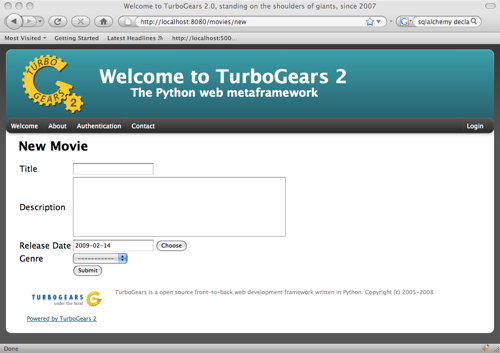
Edit Form¶
Now we just need to map a form to the edit function so that we can close the loop on our controller. The reason we need separate forms for Add and Edit is due to validation. Sprox will check the database for uniqueness on a “new” form. On an edit form, this is not required since we are updating, not creating.:
from sprox.formbase import EditableForm
class MovieEditForm(EditableForm):
__model__ = Movie
__omit_fields__ = ['genre_id', 'movie_id']
movie_edit_form = MovieEditForm(DBSession)
The biggest difference between this form and that of the “new” form is
that we have to get data from the database to fill in the form. Here
is how we use sprox.formbase.EditFormFiller to do that:
from sprox.fillerbase import EditFormFiller
class MovieEditFiller(EditFormFiller):
__model__ = Movie
movie_edit_filler = MovieEditFiller(DBSession)
Now it is a simple as adding our filler and form definitions to the
MovieController and close the loop on our presentation. Here is
what the form looks like when we go to edit it.
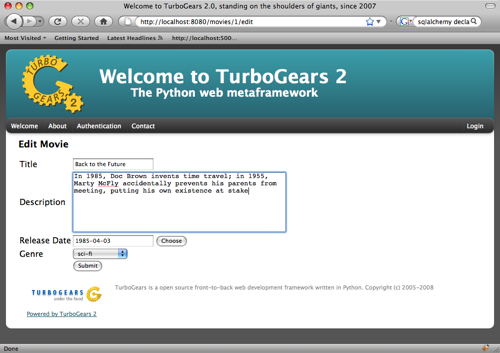
Declarative¶
If you are interested in brevity, the crud controller may be created in a more declarative manner like this:
from tgext.crud import CrudRestController
from sprox.tablebase import TableBase
from sprox.formbase import EditableForm, AddRecordForm
from sprox.fillerbase import TableFiller, EditFormFiller
class DeclarativeMovieController(CrudRestController):
model = Movie
class new_form_type(AddRecordForm):
__model__ = Movie
__omit_fields__ = ['genre_id', 'movie_id']
class edit_form_type(EditableForm):
__model__ = Movie
__omit_fields__ = ['genre_id', 'movie_id']
class edit_filler_type(EditFormFiller):
__model__ = Movie
class table_type(TableBase):
__model__ = Movie
__omit_fields__ = ['genre_id', 'movie_id']
class table_filler_type(TableFiller):
__model__ = Movie
Crud Operations¶
We have really been focusing on the View portion of our controller.
This is because CrudRestController performs all of the applicable
creates, updates, and deletes on your target object for you. This
default functionality is provided by
sprox.saormprovider.SAORMProvider. This can of course be
overridden.
Overriding Crud Operations¶
CrudRestController extends RestController, which means that any methods available through RestController are also available to CRC.
| Method | Description | Example Method(s) / URL(s) |
|---|---|---|
| get_all | Display the table widget and its data | GET /movies/ |
| new | Display new_form | GET /movies/new |
| edit | Display edit_form and the containing record’s data | GET /movies/1/edit |
| post | Create a new record | POST /movies/ |
| put | Update an existing record | POST /movies/1?_method=PUT |
| PUT /movies/1 | ||
| post_delete | Delete an existing record | POST /movies/1?_method=DELETE |
| DELETE /movies/1 | ||
| get_delete | Delete Confirmation page | Get /movies/1/delete |
If you are familiar with RestController you may notice that get_one is
missing. There are plans to add this functionality in the near
future. Also, you may note the ?_method on some of the URLs. This is
basically a hack because existing browsers do not support the PUT and
DELETE methods. Just note that if you decide to incorporate a TW in
your edit_form description you must provide a
HiddenField('_method') in the definition.
Adding Functionality¶
REST provides consistency across Controller classes and makes it easy to override the functionality of a given RESTful method. For instance, you may want to get an email any time someone adds a movie. Here is what your new controller code would look like:
class MovieController(CrudRestController):
# (...)
@expose()
def post(self, **kw):
email_info()
return super(MovieController, self).post(**kw)
You might notice that the function has the @expose decorator. This is required because the expose decoration occurs at the class-level, so that means that when you override the class method, the expose is eliminated. We add it back to the method by adding @expose. To change the functionality of a “GET” method, you would add @expose(‘genshi:tgext.crud.templates.get_all’) if you desired to use the existing exposed template.
Overriding Templates¶
To override the template for a given method, you would simple re-define that method, providing an expose to your own template, while simply returning the value of the super class’s method.:
class MovieController(CrudRestController):
# (...)
@expose(movie_demo.templetes.my_get_all_template)
def get_all(self, *args, **kw):
return super(MovieController, self).get_all(*args, **kw)
Removing Functionality¶
You can also block-out capabilities of the RestController you do not wish implemented. Simply define the function that you want to block, but do not expose it. Here is how we “delete” the delete functionality.:
class MovieController(CrudRestController):
# (...)
def post_delete(self, *args, **kw):
"""This is not allowed."""
pass
Using Dojo¶
Dojo is a JavaScript library that provides AJAX functionality, DHTML manipulation, and other functionality that works across browsers.
CrudRestController has built-in JSON functionality for the get_all function. This makes it relatively easy to integrate Dojo tables into your application. Since Sprox supports Dojo out of the box, it is simple enough to provide new imports for your custom tables and achieve infinitely scrollable tables. First, we need to install the ToscaWidgets Dojo library:
easy_install tw.dojo
Then, we create our form using Sprox’s Dojo support:
from sprox.dojo.tablebase import DojoTableBase
class MovieTable(DojoTableBase):
__model__ = Movie
__omit_fields__ = ['genre_id']
movie_table = MovieTable(DBSession)
Then, Since Dojo has a different format to fill it’s table, we must
also provide a sprox.dojo.fillerbase.TableFiller:
from sprox.dojo.fillerbase import DojoTableFiller
class MovieTableFiller(DojoTableFiller):
__model__ = Movie
movie_table_filler = MovieTableFiller(DBSession)
The resulting table looks like this.
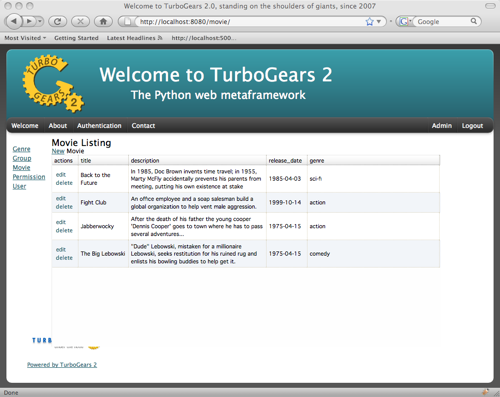
Support for more sophisticated forms has also been added to Sprox.
This is especially useful when you have a many to many relationship in
your Models. For these kinds of relationships, Dojo provides Sprox
with a SelectShuttle widget. Here is a code snippet showing how
to use the Dojo forms in your application.:
from sprox.dojo.formbase import DojoEditableForm
class MovieTableFiller(DojoEditableForm):
__model__ = Movie
movie_table_filler = MovieTableFiller(DBSession)
Since there are no many-to-many relationship objects in our example
model, here is an image of the Dojo-enabled form as it appears using
tgext.admin.
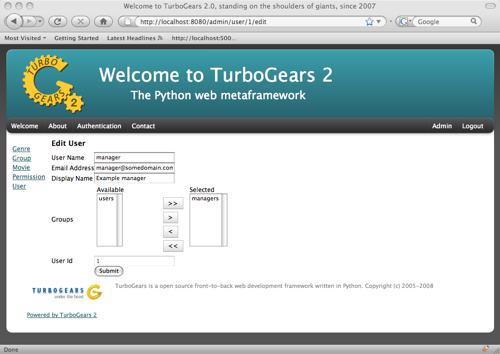
CRC: The Sweet Spot¶
CrudRestController represents sort of a sweet-spot with respect to functionality. It doesn’t do everything for you, but it can save you a bunch of work, especially when you are prototyping an application. If you need more flexibility, you should take a look at RestController, which provides no form/crud functionality. If you are really looking for something that makes all of the forms for you, but can be configured, take a look at the Turbogears Admin System.
